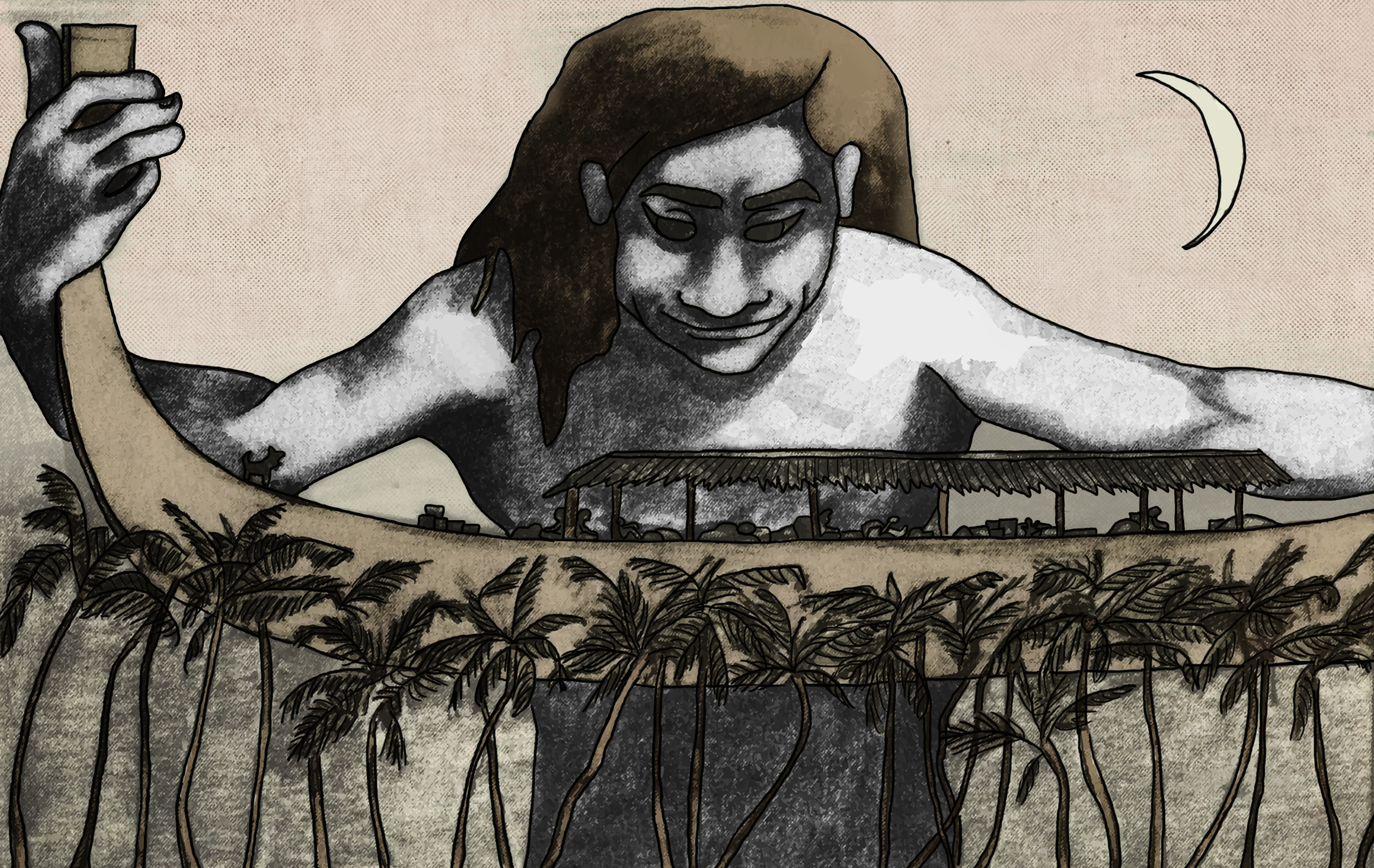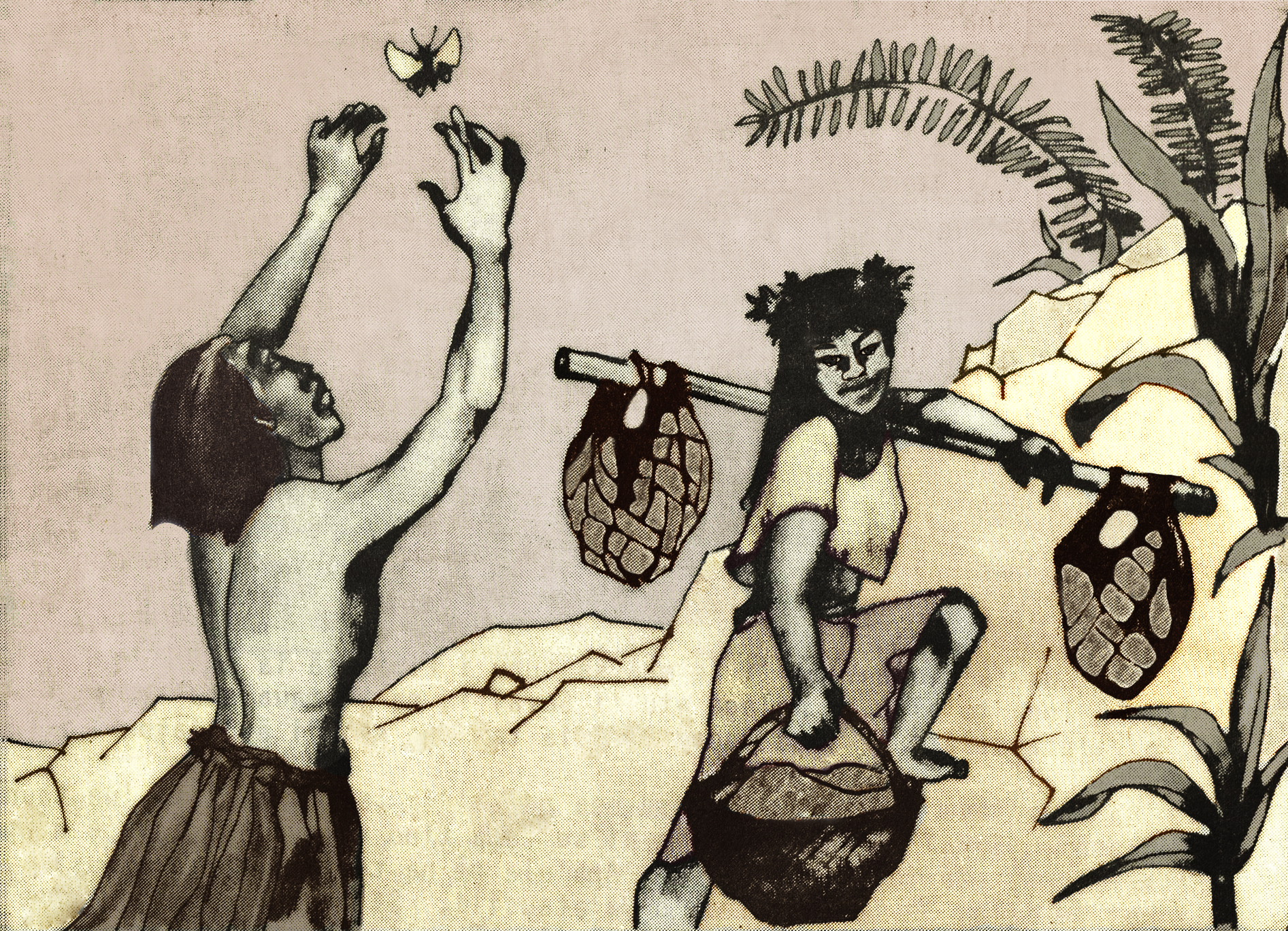
Ina ‘ua fa’alogo Vaea ‘ua taunu’u mai tagata Fiti, sā ia manatu loa ‘ua lātou ōmai e tauimasui mo le Tui Fiti. ‘E le’i ‘avea lea ma mea e fa’agae’etia ai le loto o Vaea. Sā ia savalivali lemū ane ‘i Mulinu’u, si’i le va’a ma fa’ati’eti’e i lugao uluulu o lā’au sā tutupu i tafatafa ane o letalafātai. Fa’ato’ā iloa i le taeao e tagata Fiti le tūlaga pagātia ‘ua lātou iai. ‘Q se mea ofoofoqiafa’apea, na ‘o Vaea lava na te mafaia ona fai, taluai.’e le sili atu ‘ea ’i le 500 gafa le ‘umi o lo lātou va’a? ‘Ina ‘ia fa’amalie le to’atāma’i o Vaea, sā ofoina atu e le ‘au uso lo lātou tuafafine ‘o ‘Apa’ula, sā lātou malaga mai fa’atasi,*e togisala mo ‘ilātou. Ina ‘ua va’ai atu Vaea le lālelei o le teine, sā ia talia loa ma le tu’utu’uga ‘ia vave 8 ‘ese loa ‘ilātou.atu loa ^a^tu’urnr-n e”3 ’asaoina 0 latou ola, sā lātou malaga ‘ese atu loa, ae tu.ua na ‘o st o latou tuafafine ‘o ‘Apa’ula mō Vaea. Sā vave ā^taaata^’Aūa’ula^ma usa ma lona i’uga. Ina ‘ua mavae ni nai māsina, sā ma’i- a-tagata Apa u]a,ma na toe fo i atu af loa ‘1 Fiti e fa’atali ai ona aso Jpa ;la’ sa tutu V?ea 1 lu9a ° se ”a,a 1 savalalo, ma va’ava’ai atu 1 le va a sa malaga ma mou mālie atu i le tafatafa’ilagi.
Sā solo lelei mea ‘uma mo ni nai aso; peita’i,sā fa’aletonu le sami,ma na tuai ai ona taunu u le va’a. ‘A ‘0 le’i taunū’u le va’a, sā fānau e ‘Apa’ula lana tama, 0 le tama; ma ‘ina ‘ia fa’amanatu lana toe v’a’ai ‘i si ana tane, na ia fa’aigoa ai le tama‘0 Tui Savalalo (tū i Savalalo).
Mulimuli ane na taunu’u le va’a ‘i Fiti. ‘ Ona ‘0 lona fefe i ona tua- gane ne’i lātou ‘aina si ana tama, na nanā e ‘Apa’ula ‘0 ia i talane 0 le matāfaga, sā ia mafai ona asiasi ane ‘i ai i aso ta’itasi.

Sā tupu a’e Tui Savalalo ma ‘avea ai ma tagata mālosi, sā mafai ona ia lia’i ‘i luga ni lā’au tetele pei ‘0 le velega 0 ni vao^ Peita’i, ‘0 le tasi aso na maua lava ‘0 ia e tuagane 0 lona tinā, ma ‘0 le i’uga fo’i lenā 0 si tama. Sā vave loa ona sāunia‘0 si tama mo le suāvai.
‘0 1e mea lea, sā toe fo’i ai ‘Apa’ula ‘i Sāmoa (Apia),’e ta’u atu ‘i ā Vaea ‘ina ‘ia tauia le fasiotiga 0 lona ātali’i. ‘A e pagā, sā fa’atuai tele ona toe fo’i mai 0 ‘Apa’ula. ‘0 1e fa’anoanoa tele 0 Vaea’ina ‘ua to’esea lona to’alua, na i’u ai ‘ina liua ma ma’a (mauga). Peita’i,’e taunu’u mai ‘Apa’ula, ‘0 iai pea sina ola 0 1o ‘0 totoe i le ulu o Vaea. Sā fā’apea atu ‘i ā ‘Apa’ula, “‘Ua sau ‘Apa’ula/ua tautua.” ‘Ua sau ‘Apa’ula, ‘a ‘ua tuai.
Ina ‘ua fa’alogo Vaea ‘i le mea sā tupu i Fiti, sā ia poloa’iina loa ‘Apa’ula, lona to’alua,ze malaga atu ’i Savai’i, na te maua atu_’i ai lona uso ‘0 Va’atausili. ‘0 lona uso 0 le’ā ia taui ma sui ‘i ā ‘ilatou i Fiti.
Ina ‘ua lata atu ‘i Faleālupo, sā lā ulufale ‘i se ana ma malolo ai mo le pō. _Sā tupu ai se mea ofoōfogia. Na vā’aia e le teine le tama tino va’iva’ia sā lTua ma ‘avea ‘0 se tama ‘aulelei ma le tino ‘ese, ma ona foliga pei lava ‘0 lana tāne ‘0 Vaea.’0 lenei mea, na māfua mai ai le alagā’upu Sāmoa : “‘Ua moea’itino Va’atausili.” ‘0 se mālologa i le po, na maua ai le mālosi 0 Va’atausili (‘upu tāofiofi).
Sā i’u ‘ina la’itiiti le ana ‘ae ‘ua vave ona tupu tele le tama, ma na i’u ai ‘ina malepe ma vāelua ai le ana. Sā ofo tele le teine, ma sā tagi atu e fa’apea, “‘Ua ‘ātoa tino o Va’atausili.” ‘Ua tupu ma ‘ātoa le tino o le tanr ‘ua mafai nei ona faia e tusa ma le fautuaga a Vaea. Sā lā malaga/atu loa ‘i Fiti,ma ‘o ‘inā na gaosi ai le uatogi a Va’atau sili – ‘o le ‘ogāniu tele, sā fasia ai loa e ia lea ‘auuso ‘ai tagata e to’afā ‘Ua suia ai le oti o Vaea, ‘e ui ‘ina sā lTua ia ma mauga o lo ‘o tau ‘avea ai pea lona igoa (Mauga o Vaea, i Apia, ‘Upolu)!

This story is told by Chief Seumanutafa at the request of Sooa’e as she sailed away from Saleaumua in Atua, en route to Leulumoega.
Vaea was a giant who lived behind our village in Apia harbor. One day he insulted the Tuifiti (King of Fiji). The enraged king sent his four sons with the order to kill the giant, but their ship was so large that it could not enter the harbor, instead they anchored just beyond the harbor.
When Vaea heard of the arrival of the Fijians, he surmised that they had come to avenge the Tuifiti. This did not disturb him. He calmly walked down to the bay, lifted the boat out of the sea and placed it on the tops of the trees growing near the shore.
In the morning the Fijians discovered their precarious position. Such an amazing feat could only be performed by Vaea, for their boat was 500 fathoms long! To appease the giant, the brothers offered him their sister Apaula who had accompanied them as a ransom. When Vaea saw the pretty girl he accepted, but told the brothers to leave immediately.
The brothers fled in haste, leaving their sister Apaula with Vaea, glad their lives were spared. Apaula quickly became resigned to her fate. Soon she became pregnant and returned to Fiji to await the birth. When she left, Vaea the giant stood on a stone in Savalalo, looking after the fast disappearing ship.
All went well for a while, but the ship’s progress was delayed by adverse winds. Long before they reached their destination Apaula gave birth to a boy, and in remembrance of her last view of her husband she called the child Tuisavalalo (standing in Savalalo).
Fiji was reached at last. Fearing that her vengeful brothers would kill and eat her son, Apaula left him in hiding near the shore where she managed to visit him daily.

Tuisavalalo grew up and became so strong that he could pull out big trees as if they were weeds. One day, however, he was discovered by his uncles, and that was the end of the poor boy. He was quickly dispatched and prepared for the oven.
The distraught Apaula thereupon returned to Apia to ask Vaea to avenge her murdered son. Alas, she had delayed her return too long. Grieving over the absence of his wife, Vaea had turned into stone. Only his head was still alive. It spoke and said, “Ua sau Apaula, ua tautua,” Apaula has come, but too late.
Then, hearing what had happened in Fiji, Vaea ordered his wife to go to Savai’i where she would find his brother Vaatausili. His brother would avenge them.
Apaula did as she was told. In Lealatele (Savai’i) she fell in with a puny young man who amused himself catching butterflies. Upon Apaula’s asking him if he knew Vaatausili, he replied that he himself was the man. This the girl could not believe, so she continued her search with the young man following her.
Near Falealupo they entered a cave to spend the night. There, a wonderful thing happened. The girl’s weakly companion suddenly changed into a handsome young giant bearing a marked resemblance to her husband Vaea.
From this incident, the Samoans derive the proverb: “Ua Moea’itino Vaatausili.” A nights rest gave strength to Vaatausili (upu taofiofi).
The cave, becoming too small for the fast growing giant, burst asunder. Greatly astonished the girl cried out, “Ua atoa le tino o Vaatausili.” His body is full grown, now he can do it.
They immediately travelled to Fiji, and there, armed with a coconut tree, Vaatausili slew the four cannibal brothers. Vaea was avenged, but he himself had meanwhile turned into the mountain, which even today bears his name.
Comments are closed here.